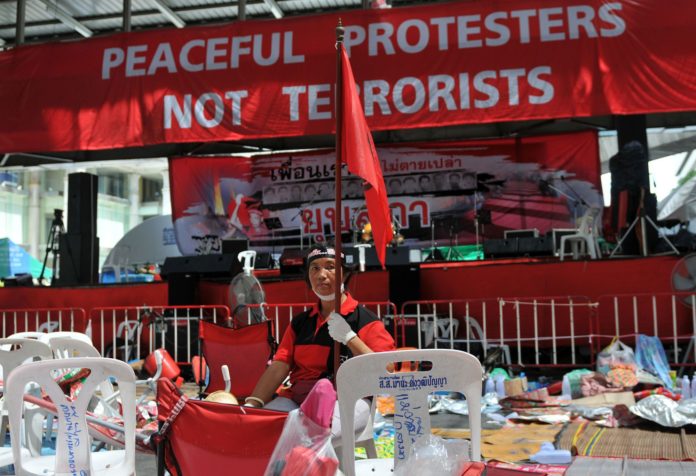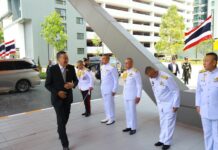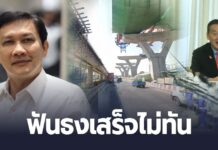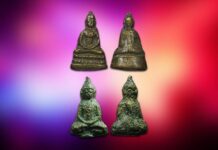| เผยแพร่ |
|---|
การรอคอยความยุติธรรมที่ยาวนานกว่า 10 ปี จากเหตุสังหารหมู่ ณ กรุงเทพฯ
โดย โรเบิร์ต อัมสเตอดัม
19 พ.ค. 63
ในระหว่างช่วงปลายเดือนเมษายนถึงต้นเดือนพฤษภาคมของปี 2553 ผมอยู่หลังซุ้มกีดขวางในถนนที่กรุงเทพฯ ร่วมกับผู้ประท้วงเสื้อแดง ซึ่งเป็นเวลาผ่านมาทั้งหมด 66 วันแล้วที่กลุ่มชุมนุมปิดยึดพื้นที่ในส่วนกลางของกรุงเทพและเป็นที่สนใจไปทั่วโลก
.
ผมได้ไปอยู่ในจุดนั้นเนื่องจากถูกส่งไปโดยอดีตนายกรัฐมนตรีของไทย ทักษิณ ชินวัตร ผู้เป็นลูกค้าของผม ผู้ที่จ้างวานให้สำนักงานกฎหมายของผมคอยช่วยเหลือให้คำปรึกษาทางด้านกฎหมายกับกลุ่มแนวร่วมประชาธิปไตยต่อต้านเผด็จการแห่งชาติ (นปช.) รวมถึงวานให้ช่วยเหลือหาหนทางด้านกฎหมายเพื่อจะปลดล็อครัฐบาล เนื่องจากในขณะนั้นประเทศกำลังตกอยู่ในกำมือรัฐบาลที่ไม่มีความชอบธรรม เข้ามาอยู่ในตำแหน่งโดยการร่วมมือกับศาลเพื่อโค่นล้มรัฐบาลเสียงข้างมากที่มาจากการเลือกของประชาชน
.
ในช่วงเวลาสำคัญนั้นได้เกิดเหตุการณ์ดุเดือดขึ้นมากมาย ไม่ว่าจะฝูงควันจากการยิงปืน รวมถึงเสียงปืนดังลั่นตลอดทั้งคืน ผมยังจำทุกอย่างได้ดี ผมอยู่ไม่ไกลเลยจากบริเวณที่มีพลทหารซุ่มยิงเสธ.แดง ในขณะที่เขากำลังให้สัมภาษณ์กับนักข่าวจากนิวยอร์คไทม์อยู่ พวกทหารฆ่าช่างภาพจากสำนักข่าวรอยเตอร์ นายฟาบิโอ โพเลนกี้ อย่างเลือดเย็น และทหารยังฆ่าเด็กที่ไม่มีอาวุธ พยาบาล แม้กระทั่งคนที่หลบภัยอยู่ในวัด พวกเราได้รับการแจ้งมาอย่างดีว่าทางรัฐบาลในขณะนั้นจะไม่ใช้ความรุนแรงกับเราพร้อมสัญญาว่าหลังจากเหตุการณ์ประท้วงจบลง จะให้มีการจัดการเลือกตั้ง ทั้งหมดนี้โดยเพิกเฉยและไร้การตอบกลับจากรัฐบาล ทุกอย่างมันชัดเจนว่ามันไม่ใช่แค่การจะสลายการชุมนุม แต่มันคือการใช้ความรุนแรงกดปราบกลุ่มผู้ชุมนุมและเป็นการก่อการร้ายต่อประชาชนไทยโดยรัฐบาลเสียเอง
.
การปราบล้างจบลงวันที่ 19 เมษายน โดยกลุ่มชายชุดดำใช้ปืนยาวซุ่มยิงมาจากบริเวณรางรถไฟบีทีเอส พร้อมกับมีรถถังและรถติดอาวุธเคลื่อนมายังบริเวณที่มีตั้งซุ้มปิดล้อม ผมโชคดีที่หลบหนีไปฮ่องกงได้ทัน แต่มีอีกหลายคนที่โชคร้ายในวันนั้น มากกว่า 98 คน โดยสังหารด้วยน้ำมือของกองทหารไทย และมากกว่า สองพันคนได้รับบาดเจ็บจากปฏิบัติการสลายการชุมนุมนองเลือดนี้โดยคำสั่งคือนายอภิสิทธิ์ เวชชาชีวะ นายกรัฐมนตรีในขณะนั้น และประยุทธ์ จันทร์โอชาผู้สั่งงานปฏิบัติการทางการทหารที่กลายมาเป็นคนทำรัฐประหารต่อมา
.
หลายครอบครัวต้องโศกเศร้ากับการตายของคนในครอบครัวที่ถูกทหารไทยพรากชีวิตไปแต่ทหารผู้เป็นคนฆ่าไม่มีใครถูกดำเนินคดี ความเจ็บปวดของครอบครัวเหยื่อและความทรงจำของพวกเขาไม่ได้หายไป แต่คนที่สั่งฆ่า คนที่สนับสนุนและคนที่ได้ผลประโยชน์จากการฆ่าคนในครั้งนี้ยังลอยนวล
.
สังคมการเมืองไทยยังมีอะไรให้คนรุ่นหลังได้เรียนรู้อีกมากมาย เหตุการณ์ครั้งนี้ถือเป็นการต่อสู้เพื่อประชาธิปไตยและมันพิสูจน์ให้เห็นว่ามีคนกลายกลุ่มพร้อมปล่อยให้ระบอบประชาธิปไตยถูกทำลายลงไป หากคุณมองกลับไปถึงประวัติศาสตร์ชาติไทยในตอนที่เราได้รับผลกระทบจากนโยบายต่างประเทศของอเมริกาซึ่งทำให้ไทยแบ่งแยกออกเป็นสองฝักฝ่ายจากการปราบปรามการประท้วงทางการเมืองตั้งแต่ปี 2516 ปี 2519 และ ปี 2536 แม้กระทั่งเมื่อไม่นานมานี้จากนโยบายของโอบาม่าที่หันกลับมาให้ความสนใจในเอเชีย เราจะเห็นได้ว่าสื่อต่างประเทศทั้งหลายไม่ได้ให้ความสำคัญกับการรายงานข่าวในรัฐประหารปี 2549 และปี 2552เลย ยิ่งกว่านั้นการสังหารหมู่ปี 2553 ก็ไม่มี ซึ่งเปรียบเหมือนเป็นการให้ความชอบธรรมและเข้าข้างกับฝ่ายเผด็จการ ทำไมเขาถึงได้คาดการณ์อะไรผิด ๆแบบนั้นกันนะ?
.
ข้อสรุปในความผิดพลาดครั้งนี้คือการสูญเสียชีวิตผู้คน สูญเสียอาชีพ การถูกจับเข้าคุกและการสูญเสียสิทธิทางการเมืองของคนเป็นล้านนำมาซึ่งการไร้สิทธิมนุษยชนและเสรีภาพ
.
ในวันนี้สิบปีที่แล้วหลังจากการสังหารหมู่ เรายังต้องทำหน้าที่เพื่อระลึกถึงความสูญเสียต่อไป มันถือเป็นความรับผิดชอบของพวกเราที่จะเตือนพวกมีอำนาจให้รู้ว่าคนต้องไม่ตายฟรีและการกระทำของพวกทหารป่าเถื่อนจะถูกจดจำต่อไป อนาคตอยู่ในกำมือคนรุ่นใหม่และเราหวังว่าความจริงนี้จะถูกเปิดเผยมากยิ่งขึ้นในอนาคต
.
แถลงการณ์ของ Robert Amsterdam
.
Still Waiting for Justice 10 Years after the Bangkok Massacre
.
By Robert Amsterdam
.
In late April and early May of 2010, I found myself on the streets of Bangkok behind the barricades among the Red Shirt protest movement, which had captured the world’s attention with their 66-day long rally occupying a central area of the capital.
.
I had been sent there by my client, the former Prime Minister Thaksin Shinawatra, who had engaged our law firm to provide legal assistance to the United Front for Democracy against Dictatorship (UDD) and to try to help find a solution to the impasse, as the country was currently under an illegitimate government that had been forced into place via rigged court rulings to invalidate the democratic majority.
.
During those crucial weeks, events were quickly slipping out of control. The memories of the fatigue-inducing heat, the acrid smoke from the fires, and the gunshots ringing out all night remain visceral to me. I was just a few blocks away on the street when a sniper assassinated one Red Shirt leader, Seh Daeng, with a shot to the head while was he was literally doing an interview with a New York Times reporter. They brutally executed the Reuters photojournalist Fabio Polenghi. They were killing unarmed children, nurses, and even passersby seeking refuge at temples. We presented a very clear and frankly desperate offer to the government to avoid bloodshed, promising an immediate end to the protests in exchange for fresh elections – an offer which was ignored and silenced. The message was clear – their goal wasn’t to clear the rally, it was to violently crush the movement and terrorize the Thai people into submission.
.
The final sweep concluded on May 19, as men in black uniforms took sniper positions on the elevated BTS train lines and tanks and armored cars rolled over the barricades. I was fortunate to safely evacuate to Hong Kong. Many others were much less fortunate. More than 98 people were murdered by the Thai military in a handful of days, and more than 2,000 injured in a military operation ordered by then-Prime Minister Abhisit Vejjajiva and the current coup-appointed Prime Minister Prayut Chan-ocha.
.
On this mournful ten-year anniversary of the Bangkok Massacres, I wanted to take the opportunity to re-release our comprehensive white paper documenting these events, “A Call for Accountability,” which was published in July 2010. Given the tragic arc of events that have taken place in the past ten years in Thailand, the contents of the paper remain sadly quite contemporary.
.
The grieving families of those killed by the Thai military have still not been offered the justice they deserve. Their pain continues each and every day, and the memories have not faded. The impunity enjoyed by the killers, their sponsors, and those who have benefitted has remained entirely intact, while dress rehearsals of truth and reconciliation efforts have been comically performative and devoid of substance or meaning.
.
There is much to learn about how the world stood back and let democracy die in Thailand. You could look back to the historical impact of interventionist U.S. foreign policy which established Thailand’s dual state, the failures to demand accountability after massacres in 1973, 1976, and 1992, or you could even fast forward to find numerous strategic flaws in the Obama administration’s “pivot to Asia” strategy (spoiler alert: it backfired). You could point to the incomprehensible global media coverage and responses by the NGO community to the 2006 coup, the 2008 judicial coup, or even the 2010 massacre and the events following which did so much to legitimize the slide toward outright dictatorship. How they could have possibly gotten it so horribly wrong?
.
The culmination of these failures can be counted in lives lost, careers destroyed, thousands imprisoned and millions deprived of their rights to representation and basic human rights and liberties.
.
On this day, ten years after the massacres, we have a duty to remember all the lives lost, a responsibility to continue reminding those in power that impunity will not be tolerated forever and their crimes will never be forgotten, and a commitment to upholding the dignity and sanctity of each and every soul living in this beautiful, complex, and indispensable country. The future belongs to the young people of Thailand, and the truth will demand to be heard.







